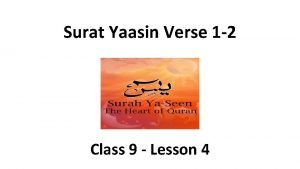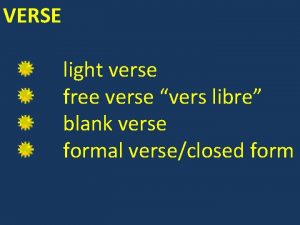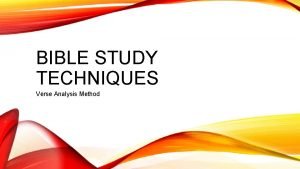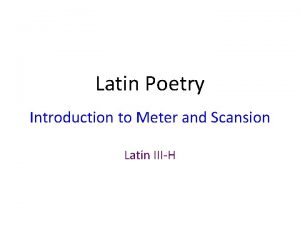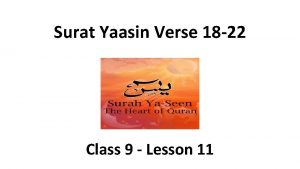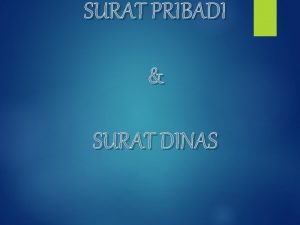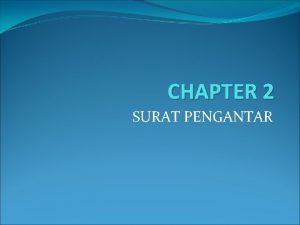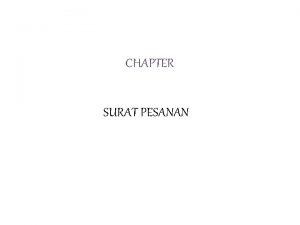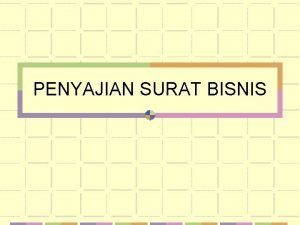Surat Yaasin Verse 1 2 Class 9 Lesson










- Slides: 10

Surat Yaasin Verse 1 -2 Class 9 - Lesson 4

Starter Activity • There are 29 chapters of the Qur’an which start with the “Disjointed Letters” (al-huruf al-muqatta’aat) – How many can you find? Alif Lam Mim al-Baqarah, 2; Ali `Imran, 3; al-`Ankabut, 29; al-Rum, 30; Luqman, 31; al-Sajdah, 32 Alif Lam Mim Sad al-A`raf, 7 Alif Lam Ra Yunus, 10; Hud, 11; Yusuf, 12; Ibrahim, 14; al-Hijr, 15 Alif Lam Mim Ra al-Ra`d, 13 Kaf Ha Ya `Ain Sad Maryam, 19 Ta Ha, 20 Ta Sin Mim al-Shu`ara, 26; al-Qasas, 28 Ta Sin al-Naml, 27 Ya Sin, 36 Sad, 38 Ha Mim Ghafir, 40; Fussilat, 41; al-Zukhruf, 43; al-Dukhan, 44; al-Jathiya, 45; al-Ahqaf, 46 Ha Mim `Ain Sin Qaf al-Shura, 42 Qaf, 50 Nun al-Qalam, 68

Learning objectives: • To provide an explanation of the various possible meanings of Yaasin • To provide an explanation of the first two verses of Surat Yaasin

Sura Yasin ﻳ ﺍﻟ ﺍﻟ In the name of Allah, the Beneficent, the Merciful ﻳﺲ Yaa-Sin [1] ﺍﻳ ﺍآ (I swear) by the Quran full of wisdom, [2] ﺍﻳ you are indeed one of the messengers, [3] ﻳ ﺍ ﻯ on a straight path. [4]

Verse 1: • The first verse of this chapter, “Yaa-Sin”, can be explained in one of three ways: 1. These two letters are from the “Disjointed Letters” (al-huruf al-muqatta’aat) found in the beginning of 29 chapters of the Qur’an. Ø Examples: “Alif, Laam, Mim” (Surat Baqarah) and “Kaaf, Haa, Yaa, Ayn, Saad” (Surat Maryam). Ø Many different speculations have been made by scholars as to the meaning of these letters, but it suffices for this lesson, to understand these letters as a secret communication between Allah (SWT) and his chosen servants, the Ma’sumin (A), which we have no knowledge about. 2. Yaasin is an abbreviation of the statement “Oh human being” (Yaa Insaan). Ø The yaa is the Arabic vocative particle “Oh”, used in many Qur’anic verses like “Oh you who believe” (yaa ayyuhal ladheena aamanu), Ø The sin is an abbreviation for insaan = “human being”. 3. Yaasin is one of the names of the Holy Prophet (S), whose exact meaning is unknown to us. Ø Hence, the sentence flows with the following verses of the chapter – “Yaa-Sin, by the wise Qur’an, you are indeed one of the messengers” • Do you know another sura which starts with disjointed letters also the name of the Prophet?

The names of Holy Prophet in the Qur’an In one hadith attributed to Imam Ali (A), we are told that the Holy Prophet (S) has been referred to by seven different names in the Qur’an: 1. Muhammad – The most praised one 2. Ahmad – Much praised 3. Yaasin - Hence, the Imams are sometimes referred to as “Aal Yaasin” (the progeny of Yaasin). 4. Ta. Ha 5. Muzzammil – The enshrouded one 6. Muddaththir - The wrapped one 7. Abdullah – The slave of Allah Do you know the meanings of these names?

The names of Holy Prophet in the Qur’an cont. 1. Muhammad [3: 144; 33: 40; 47: 2; 48: 29]. Here’s one example: ﻳﺍ ﺍﻟ ﺍ ﻳ ﺍﻟ ﺍ ﺍﻟ ﻭ ﻥ ﺍ ﻥ ﺍ ﺍ ﺍ Muhammad is not the father of any of your men, but he is the Messenger of Allah and the seal of the Prophets. Allah has full knowledge of everything. [33: 40] 2. Ahmad [61: 6]: ﻳ ﺍ ﺍﻭﺍ ﺍ ﺍ ﺍﻡ ﺍ ﺍ ﻱ ﻥ ﻱ ﻭ ﺍ ﺍ ﺍﻟ ﺍ ﺍ ﻡ ﺍﻟ ﻭ ﻱ ﺍﻳ ﻱ ﺍ ﺍ ﻳﻯ ﺍ And call to mind when Jesus, son of Mary, said: “O Children of Israel, I am Allah's Messenger to you, I verify the Torah which has come before me, and I give you the glad tiding of a Messenger who shall come after me, his name being Ahmad. ” Yet when he came to them with Clear Signs they said: “This is sheer trickery. ” [61: 6] 3. Ta. Ha [20: 1]: ﻯ ﺍآ ﻧﺍ ﺍ ، ﻃﻪ Ta Ha! We did not reveal the Qur'an to you to cause you distress; [20: 1 -2] 4. Muzzammil [73: 1]: ﺍ ﺍ ﺍ O you wrapped up in your mantle! [73: 1] 5. Muddaththir [74: 1]: ﺍ ﺍ ﺍ O you wrapped up in your mantle! [74: 1] 6. Abdullah [72: 19]: ﺍ ﻭﻭ ﺍﻭﺍ ﻭ ﺍﻟ ﺍ ﺍ When the servant of Allah rose to pray to Him, they almost crowded around him. [72: 19]

Verse 2: ﺍﻳ ﺍآ (I swear) by the Quran full of wisdom Why does Allah (SWT) swear by various things in the Qur’an? • Of course, Allah (SWT) does not need to take any oath, but the oaths of the Qur’an have always two important usages: 1. The emphasis on the concerning matter, 2. The statement of the greatness of the thing by which is sworn, for nobody takes an oath to the worthless things. • In other words, a very important message is about to be revealed and Allah (SWT) wants us to humble ourselves, empty our minds and hearts of all other concerns and pay full attention to what is about to be revealed. • Can you think of other things that Allah has sworn by in the Qur’an?

Verse 2 cont: Why does Allah (SWT) describe the Qur’an as “Hakeem” in this verse as opposed to the many other descriptions of the Qur’an used in other verses? • “Hakeem” (wise), is usually used for someone who is alive and possesses the rare and extremely valuable quality of being insightful. • It is as if Allah (SWT) wants us to recognise the Qur’an as a wise and living leader, which has the ability to open the doors of wisdom to human beings, as well as guide us along the fastest and safest path to success in this world and the Hereafter. As mentioned in another verse of the Qur’an: ﻳﺍ ﺍ ﺍﺍ ﺍﻟ ﻭ ﺍﻳ ﻱ ﻱ ﺍآ ﺍ Surely this Quran guides to that which is most upright and gives good news to the believers who do good that they shall have a great reward. [17: 9]

HOMEWORK: 1. Complete the reflections you started in class today. 2. Memorise the first 2 verses of Surat Yaasin studied today.
 Surat to sin mim
Surat to sin mim Free verse blank verse
Free verse blank verse Free verse vs blank verse
Free verse vs blank verse Then must you speak of one that loved not wisely
Then must you speak of one that loved not wisely Then must you speak of one that loved
Then must you speak of one that loved Verse by verse bible study method
Verse by verse bible study method The possessive sharon olds
The possessive sharon olds Free vs blank verse
Free vs blank verse Dactylic hexameter
Dactylic hexameter Free verse poem generator
Free verse poem generator Tanggal surat pada buku agenda surat masuk diisi .... *
Tanggal surat pada buku agenda surat masuk diisi .... *
